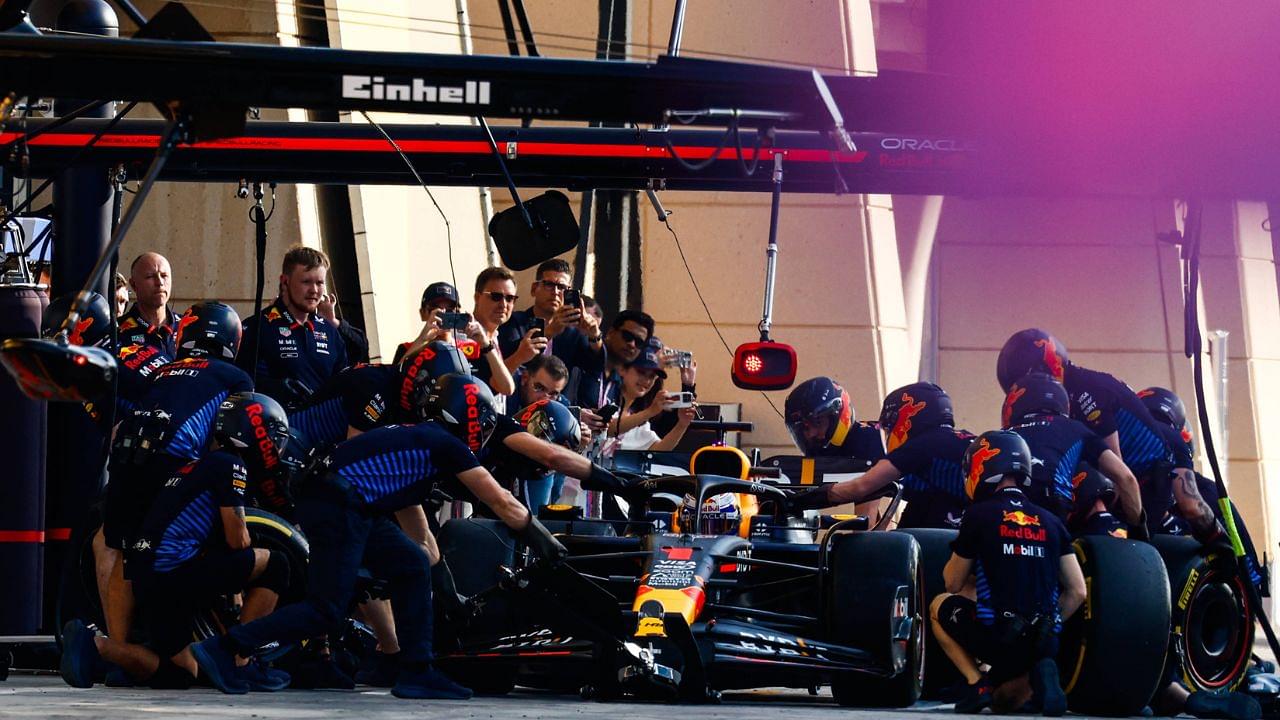In Formula 1, the role of a pit crew is nearly as important as that of a driver and the rest of the team. Often regarded as the ‘unsung heroes’ of F1, the pit crew operates in the smallest of windows with utmost precision to ensure their drivers gain a competitive edge over others while racing. Given the same, the question of how much a pit crew member earns often arises. According to information gathered from Pinkvilla, the salaries of pit crew members vary depending on the importance and intensity of the role.
With a diverse range of roles on offer in a pit crew, the annual salary ranges widely. People playing the role of a ‘fire extinguisher man’ earn roughly $30,000 annually. Meanwhile, the pit crew chief earns up to $1 million annually. Furthermore, win bonuses act as incentives for each person to boost their performance.
Salary Structure of F1 pit crew
| Pit Crew Member | Per Race Payment | Annual Salary | Race Winning Bonus |
| Crew Chief | $10,000 | $1 Million | $5,000 |
| Refueling Person | $5,000 | $350,000 | $2,500 |
| Tyre Changers | $5,000 | $350,000 | $2,500 |
| Tyre Carriers | $3,500 | $270,000 | $2,500 |
| Jack Men | $3,000 | $150,000 | $500 |
| Wing Men | $3,000 | $150,000 | $500 |
| Stabilizer | $2,500 | $90,000 | $250 |
| Starter Man | $750 | $40,000 | $250 |
| Fire Extinguisher Man | $500 | $30,000 | $250 |
Role of each pit crew member in F1
Crew Chief –
A crew chief is the leader of the pit crew. They are responsible for overseeing and coordinating the team’s operations during pit stops. A crew chief also makes strategic decisions to ensure flawless execution of a pit stop.
Refueling Person –
Historically, this person was responsible for quickly refueling the car while managing the apparatus during pit stops. However, the latest regulations do not allow for mid-race refueling of F1 cars.
Wing Men –
They adjust the front wing angle of a car during pit stops at a driver’s request. It alters the aerodynamics of a car, affecting its handling and performance.
Starter Man –
They hold a portable starter device in case a car stalls during a pit stop. This role is critical in preventing issues if a car needs to restart mid-race.
Fire Extinguisher Man –
They handle any fire-related emergencies during a pit stop. Though such incidents are rare, safety is always a priority. The presence of highly inflammable fuel and hot components makes the role a critical element in any pit crew.
Stabilizer –
They ensure an F1 car is steady and secure on the jacks during tire change. It helps prevent any movement that could slow the pit stop down or lead to any personnel getting injured.
Jack Men –
Jack Men are responsible for lifting an F1 car off the ground to aid in tire changes. Two jackmen deploy at the front and back of the car and lift the car up using specialized hydraulic jacks.
Tire Carriers –
They are the closest accomplices to tire changers. Carriers hand changers the new tires in exchange for the old ones. The synergy between them is key to minimizing the time taken to change a tire. One tire changer and one carrier pair up for each of the tires.
Tire Changers –
Tire changers have the task of replacing older tires with newer tires during pit stops, according to the team’s strategy. Precision and speed are key in the role, as they use pneumatic guns to unscrew and re-screw the wheel nuts.
1.80 ⏱️
McLaren set the new WORLD RECORD for the fastest pit stop in Formula 1 at the Qatar Grand Prix 23 for this Lando Norris stop…⚡️
Beating the previous record set by Red Bull for Max Verstappen’s stop in Brazil 19 (1.82)…
Congrats#QatarGP #F1 pic.twitter.com/Hndxbfg3fO
— Opinionated Fan (@OpinionatedSF19) October 9, 2023
Why do F1 cars change tires mid-race?
Aside from its high-speed combat, F1 is also a battle of wits. Strategic planning and its execution often end up making all the difference in the world. A pit stop is one of the most crucial elements of the strategy, and tire changes are the primary reason behind the same.
Tires act as the only point of contact between a car and the track. Their condition and wear & tear affect the car’s overall performance, including speed and grip. Hence, tire changes are crucial in F1 owing largely to degradation and the various compounds available for teams to use.
Tire Degradation –
As cars run on tracks at high speeds, the tires continue to wear away. This leads to a loss of grip and speed, resulting in increased lap times. It also makes the car harder to handle on track.
Tire Compounds –
In F1, there are different types of tire compounds, offering varying levels of performance and durability. Teams have to choose the right tire for the right moment to switch between compounds and optimize their performance.
In 2024, five kinds of tires, classified from C1 to C5, will be available for teams to use. C1 tires are the hardest, while C5 are the softest tires in F1. Red (soft) tires are the quickest over a lap but are the least durable. Yellow (medium) tires offer the perfect balance between speed and durability. White (hard) tires are the most durable of the three but offer the least pace.
Blue or green (sidewall) tires, also known as wet weather or intermediate weather tires are used when the rain pours or track conditions are wet as they offer extra grip at the cost of speed.
Pirelli ha annunciato il numero di set di gomme che verrano usati nei test#F1 #F1Testinghttps://t.co/58zuSsJigE
— F1INGENERALE (@F1ingenerale_) February 21, 2024
How to become a part of a team’s pit crew?
Listings for an opening for a pit crew member in F1 are a rarity. These positions are generally taken up by pre-existing personnel such as engineers and technicians. However, a strong education is often a necessity to take up a role. Knowledge of the automobiles and the motorsport industry is a basic requirement.
Furthermore, certification in pit crew training and sufficient physical fitness are other key factors. Directly landing a pit crew role isn’t generally an option, and thus, one has to apply for a different position in a team and work their way upwards.
What is the highest-paid job in F1?
Drivers act as the face of F1 teams and are responsible for a team winning the constructors’ championship. Given the responsibility of the entire team’s hard work relies on their shoulders, it is no surprise they are the highest-earning employees in the sport. Given below is a breakdown of the annual salary of each driver in F1, according to RacingNews 365.
Lewis Hamilton’s contract with Ferrari will reportedly pay him over $100 million per year
An average annual salary in that range would’ve put him among the top ten athletes in total earnings last year:
Cristiano Ronaldo $136 million
Lionel Messi $130 million
Kylian… pic.twitter.com/sQ8jd5eDMq— Morning Brew ☕️ (@MorningBrew) February 2, 2024
| Driver | Team | Salary +/- in $ million | |
| Max Verstappen | Red Bull Racing | 55 | |
| Lewis Hamilton | Mercedes | 45 | |
| Charles Leclerc | Ferrari | 34 | |
| Lando Norris | McLaren | 20 | |
| George Russell | Mercedes | 18 | |
| Fernando Alonso | Aston Martin | 18 | |
| Checo Perez | Red Bull Racing | 14 | |
| Carlos Sainz | Ferrari | 12 | |
| Valtteri Bottas | Stake F1 Team | 10 | |
| Daniel Ricciardo | Visa Cash App RB | 7 | |
| Esteban Ocon | Alpine | 6 | |
| Pierre Gasly | Alpine | 6 | |
| Oscar Piastri | McLaren | 6 | |
| Kevin Magnussen | Haas F1 | 5 | |
| Alexander Albon | Williams | 3 | |
| Lance Stroll | Aston Martin | 3 | |
| Nico Hulkenberg | Haas F1 | 2 | |
| Guanyu Zhou | Stake F1 Team | 2 | |
| Yuki Tsunoda | Visa Cash App RB | 1 | |
| Logan Sargeant | Williams | 1 |








